Panasonic Lumix G Vario PZ 45-175mm f/4-5.6 M43 Lens
Panasonic Lumix G Vario PZ 45-175mm f/4-5.6 Lens Performance
At 45mm and maximum aperture sharpness in the centre is already excellent and good towards the edges of the frame. Stopping down to f/5.6 results in a slight increase in sharpness across the frame but sharpness is best from edge to edge at f/8, where performance is excellent across the frame.As no focal lengths are marked on the zoom, the middle point of the zoom range chosen for testing ended up being 112mm. At this focal length clarity in the centre of the frame at maximum aperture remains excellent but sharpness towards the edges has dropped to fairly good levels. Again peak sharpness across the entire frame is achieved at f/8, where sharpness approaches excellent levels across the frame.
Excellent sharpness in the centre is maintained at f/5.6 and 175mm and the quality towards the edges rises to very good levels. Again peak quality across the frame is achieved at f/8, where sharpness in the centre is excellent, and very good towards the edges.
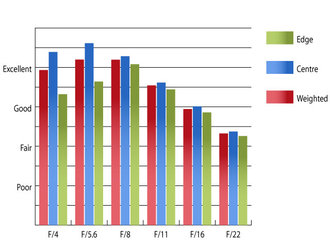 Resolution @ 45mm | 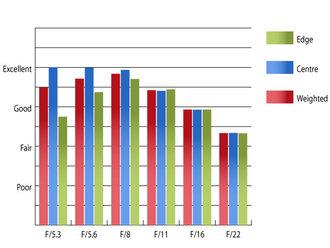 Resolution @ 112mm | |
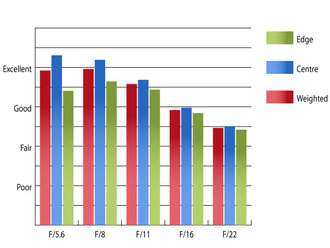 Resolution @ 175mm | How to read our chartsThe blue column represents readings from the centre of the picture frame at the various apertures and the green is from the edges. Averaging them out gives the red weighted column.The scale on the left side is an indication of actual image resolution. The taller the column, the better the lens performance. Simple. For this review, the lens was tested on a Panasonic Lumix G3 using Imatest. |
Chromatic aberrations are remarkably well controlled throughout the zoom range. At its worst, fringing just exceeds half a pixel width towards the edges of the frame at 175mm and f/22. This extremely low level should pose few issues, even in large prints and harsh crops from the edges of the frame. Throughout the rest of the zoom, chromatic fringing is barely detectable.
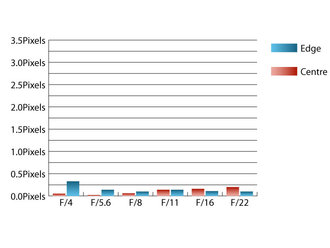 Chromatic Aberration @ 45mm | 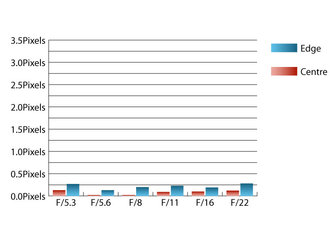 Chromatic Aberration @ 112mm | |
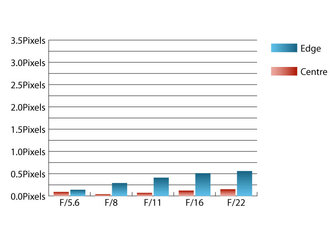 Chromatic Aberration @ 175mm | How to read our chartsChromatic aberration is the lens' inability to focus on the sensor or film all colours of visible light at the same point. Severe chromatic aberration gives a noticeable fringing or a halo effect around sharp edges within the picture. It can be cured in software.Apochromatic lenses have special lens elements (aspheric, extra-low dispersion etc) to minimize the problem, hence they usually cost more. For this review, the lens was tested on a Panasonic Lumix G3 using Imatest. |
Falloff of illumination towards the corners is reasonably well controlled. At 45mm the corners are 1.53 stops darker than the image centre. At 175mm the corners are only 0.95 stops darker than the image centre. Illumination is visually uniform at f/8 throughout the zoom range.
Distortion is very well controlled with 0.139% barrel distortion being present at 45mm and 0.506% pincushion at 175mm. These distortion levels are very slight and should pose few issues in normal photography. If you do require absolutely no distortion, the small amount that is present is easily corrected in image editing software afterwards, as the distortion pattern is uniform across the frame.
This lens is one of a few from Panasonic that sport their Nano Surface Coatings to reduce flare and loss of contrast. Even when shooting into the light, it is very difficult to create lens flare with this optic and contrast is retained remarkably well.
Add your message
Login required
Please login here or if you've not registered, you can register here. Registering is safe, quick and free.
Please login here or if you've not registered, you can register here. Registering is safe, quick and free.
photodo Stats
1102 lenses
428 MTF tests
74 in-depth photodo reviews
100+ users join each day
Help the lens community by reviewing or rating a lens today via our lens search
428 MTF tests
74 in-depth photodo reviews
100+ users join each day
Help the lens community by reviewing or rating a lens today via our lens search
Latest Lens Reviews
- Chinon 28mm f/2.8 Vintage Lens Review
- Canon EF 70-200mm f/4L IS II USM Lens Review
- Samyang AF 85mm f/1.4 EF Review
- Sigma 70mm f/2.8 DG Macro Art Review
- Samyang AF 24mm f/2.8 FE Review
- Meike 50mm f/1.7 Review
- Tamron 70-210mm f/4 Di VC USD Review
- Lensbaby Burnside 35mm f/2.8 Review
- Asahi Super Takumar 50mm f/1.4 Review
- Asahi Super-Multi-Coated Takumar 135mm f/3.5 Review
